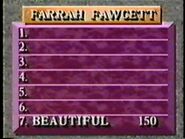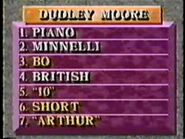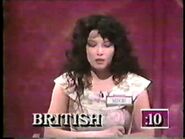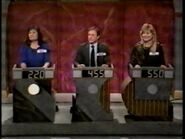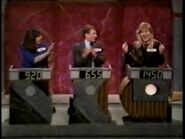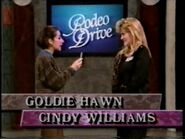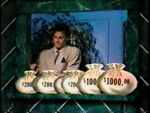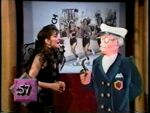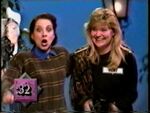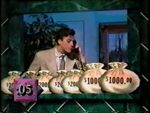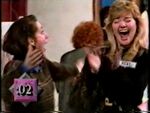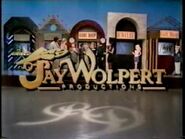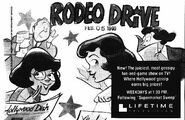| Hosts | |
| Peter Tomarken (1980) Louise DuArt (1990) | |
| Announcer (1990) | |
| Burton Richardson | |
| Broadcast | |
| Unsold Pilot: 10/1980 Lifetime (Daily): 2/5/1990 - 8/31/1990 | |
| Packagers | |
| Metromedia Producers Corporations (1980) Jay Wolpert Productions | |
LOUISE: Hi everybody, I'm Louise DuArt. Thank you, thank you. I've just found out something that's really hard to believe about one of the famous people who shop along the street. (insert statement) Could this be true? Well, we'll find out on the street of stunning stores and stories where the glitter meets the dirt... "Rodeo Drive"! BURTON: And hoping to stroll down Rodeo Drive today are, (insert hometowns and contestants). And once again, here's Louise DuArt!
Rodeo Drive was a short-lived game show where three contestants played a game all about celebrity gossip based on the world famous Beverly Hills street of the same name.
Main Game
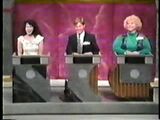
Here are three contestants ready to play.
Round 1
To start, a monitor opens up behind & over the contestants. On that monitor is a game board with seven hidden words connected to a famous celebrity past or present. On his/her turn, the contestant chose a number from 1 through 7. The word was revealed to the home audience as well as his/her two opponents, after which the opponents predicted in secret whether the contestant in control would say the word or not. (Upon a word choice, announcer Burton would tell the home viewers what the word is and how it associates with the celebrity.) The contestant in control had 15 seconds to "do some gossiping" – in other words, to describe the celebrity as much as possible. If the contestant said the chosen hidden mystery word in 15 seconds they won a hidden point value next to that word (anywhere from 100 to 250 points based on the difficulty of the word). If he/she can't, the contestant still received five points for each of the remaining six words that player did say. Then the other players' predictions were revealed and a correct prediction was worth 50 points. Play continued until all three contestants had described one celebrity and predicted twice. If two players were tied at the end of the round, a toss-up true or false statement about a celebrity was read. The first player to buzz-in with correct answer scored one point (preventing any further ties involving that player) and the advantage in round 2. An incorrect answer automatically gave the opponent the point and the advantage.
Round 2 (Fact or Rumor)
The contestants were rearranged and seated from left to right in order of how they finished the first round. In this round host DuArt read a series of statements about celebrities, each one being either a fact (a true statement) or a rumor (a false statement). Play started with the first-place player and guessed if the statement given was a fact or a rumor. A correct answer earned that player 100 points and kept control, but an incorrect answer passed control to the second-place player. That player continued answering questions until he/she missed, at which point the third-place player gained control. An incorrect answer from the third-place player gave control back to the first player. During this round, host DuArt would also do her famous voice impersonations, appropriate to that question's subject, more often if the answer was wrong. The round lasted for approximately seven minutes. When two bells rang, it was a two-minute warning, and when more bells rang, the round and the game was over. The player with the most points at the end of the game won the game. If the game ended in a tie, a tiebreaker similar to that used in Round 1 was used to determine a winner. The winner of the game became the champion, won $500 and went "Window Shopping & Eavesdropping" down Rodeo Drive for thousands of dollars in cash and prizes.
Rodeo Drive (Bonus Round)
Before going to Rodeo Drive, the championship player was asked five more questions to increase the money deposited in the Rodeo Drive bank with the basic starting amount being $1,000. On each question, host DuArt gave a choice of two celebrity names. Sometimes the answer could be one of the celebrities; other times the answer could be both. Each correct answer added $200 more to the bank.
After the second commercial break, the winning contestant along with Louise went strolling down Rodeo Drive which consisted of four shops and the bank. On each store, the winning contestant was overhearing some gossip about a celebrity. If the contestant can guess who's being talked about he/she moved on to the next store. If the contestant can get pass all four stores and the bank in 60 seconds or less, he/she won all four prizes and all the money in the bank. If the contestant can't do that when time ran out, he/she still won a choice of any of the prizes from the stores passed. Either way, the contestant returned to play the next show as champion.
1980 Pilot Rules
Main Game
Round 1
The contestants were each given a $500 stake to start. Peter read three statements about celebrities which are either fact or rumor. Fact meaning true, rumor meaning false. On each question, the contestant bet in secret either $100, $200 or $300 and then lock in their fact or rumor guess. Correct answers added the bet. Incorrect answers deducted the bet.
Round 2
This round was played the same way as the 1990 series. More fact or rumor questions were asked, but at a rapid-fire pace. The players took turns trying to build up their scores toward the goal of $1,500. Each correct answer was worth $100 and the first player to reach $1,500, wins the game and went shopping on Rodeo Drive.
Bonus Round
The winning player shopped at various stores on the street. The object of the game was to collect at least $2,500 in prizes.
Music
Chip Lewis
Inventors
Jay Wolpert, Randall Neece, and Roger Speakman
Studio
CBS Television City, Hollywood, California
Trivia
- This show premiered on the same day as the new Supermarket Sweep, with the latter running for several more years.
- The sound used for a correct answer in the first two rounds was used on The Price is Right, while the sound used for an incorrect answer was used on Family Feud. The bell used to signal the end of the second round and for a correct answer in the bonus round was used on Whew! and Blackout.
Other Pictures
Links
Rules for Rodeo Drive at Loogslair.net
Rodeo Drive at tv-gameshows.com
Josh Rebich's Rules for Rodeo Drive



